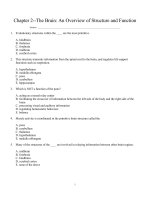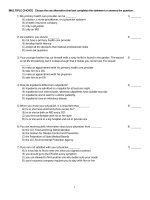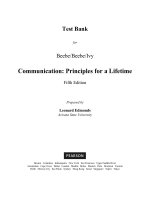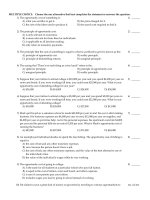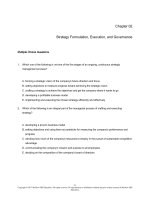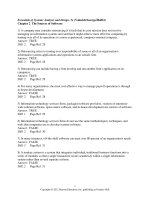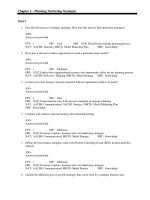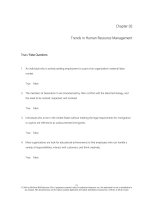Principles of biochemistry 5th edition moran test bank
Bạn đang xem bản rút gọn của tài liệu. Xem và tải ngay bản đầy đủ của tài liệu tại đây (396.37 KB, 19 trang )
Principles of Biochemistry, 5e (Moran/Horton/Scrimgeour/Perry/Rawn)
Chapter 2 Water
1) Which statement does NOT explain the polarity of water?
A) Oxygen is more electronegative than hydrogen.
B) Water molecules have a bent geometry (V-shaped).
C) The oxygen in water has sp2 hybrid orbitals.
D) In water the hydrogen carries a partial positive charge (δ+).
Answer: C
Page Ref: Section 2-1
2) The polarity of small molecules is a result of
A) the presence of oxygen.
B) the geometry of the bonds in the molecule.
C) the polar covalent bonds.
D) All of the above.
E) B and C.
Answer: E
Page Ref: Section 2-1
3) Which substance do you expect to be most soluble in water?
A) Ammonia, NH3.
B) Methane, CH4.
C) Carbon dioxide, CO2.
D) Nitrogen, N2.
Answer: A
Page Ref: Section 2-1
1
Copyright © 2012 Pearson Education, Inc.
4) Which is NOT a proper way to form a hydrogen bond? (The symbol "R" represents a general
organic group. The hydrogen bonding is represented by dashed lines.)
A) I
B) II
C) III
D) IV
Answer: B
Page Ref: Section 2-2
5) What is the maximum number of hydrogen bonds that one water molecule can have with
neighboring water molecules?
A) 1
B) 2
C) 3
D) 4
Answer: D
Page Ref: Section 2-2
6) Which statement is true about hydrogen bonds between water molecules?
A) They are about as strong as the covalent bonds in a water molecule.
B) They arise because of the linear geometry of water.
C) They cause water to have an unusually low freezing point for its molecular weight.
D) They involve the unequal sharing of a proton between water molecules.
E) In liquid water the same molecules attract to each other over long time periods.
Answer: D
Page Ref: Section 2-2
2
Copyright © 2012 Pearson Education, Inc.
7) The abundance of water in the cells and tissues helps to minimize temperature fluctuations.
This is due to what property of water?
A) Density.
B) Viscosity.
C) Specific heat.
D) Boiling point.
Answer: C
Page Ref: Section 2-2
8) Compounds that ionize when dissolved in water are called ________.
A) electrolytes
B) polar compounds
C) hydrophobic compounds
D) amphipathic compounds
Answer: A
Page Ref: Section 2-3
9) Poorly soluble molecules such as lipids and nucleoside bases can be made more soluble in
cells by attaching ________ to them.
A) water
B) oxygen
C) carbohydrates
D) salt ions
Answer: C
Page Ref: Section 2-3
10) Electrolytes dissolve readily in water because
A) they are held together by electrostatic forces.
B) they are hydrophobic.
C) water molecules can cluster about cations.
D) water molecules can cluster about anions.
E) water molecules can cluster about cations and anions.
Answer: E
Page Ref: Section 2-3
11) A molecule or ion is said to be hydrated when it ________.
A) is neutralized by water
B) is surrounded by water molecules
C) reacts and forms a covalent bond to water
D) aggregates with other molecules or ions to form a micelle in water
Answer: B
Page Ref: Section 2-3
3
Copyright © 2012 Pearson Education, Inc.
12) Which would you expect to be most soluble in water?
A) I
B) II
C) III
D) IV
Answer: A
Page Ref: Section 2-3
13) Solutes diffuse more slowly in cytoplasm than in water because of
A) the higher viscosity of water.
B) the higher heat of vaporization of water.
C) the presence of many crowded molecules in the cytoplasm.
D) the absence of charged molecules inside cells.
Answer: C
Page Ref: Section 2-3
14) The ________ pressure is the pressure required to prevent the flow of solvent through a
solvent-permeable membrane that separates two solutions of different solute concentration.
A) hydrostatic
B) electromotive
C) osmotic
D) partial
Answer: C
Page Ref: Section 2-3
4
Copyright © 2012 Pearson Education, Inc.
15) Which is true about the solubility of electrolytes in water?
A) They are all insoluble in water.
B) They are usually only sparingly soluble in water.
C) They often form super-saturated aqueous solutions.
D) They readily dissolve and ionize in water.
Answer: D
Page Ref: Section 2-3
16) What is the difference between a particle being hydrated versus being solvated?
A) A hydrated particle is surrounded by a shell of water. A solvated molecule is surrounded by a
shell of solvent molecules, not necessarily water.
B) The terms hydrated and solvated mean exactly the same thing.
C) A hydrated particle has reacted with hydrogen. A solvated particle is dissolved in a solvent.
D) The word hydrated is used only when the solute is an electrolyte.
Answer: A
Page Ref: Section 2-3
17) The osmotic pressure of an aqueous solution depends on
A) the chemical nature of the solute.
B) the molar concentration of solute.
C) the hydrophobic effect of the solute.
D) All of the above.
E) None of the above.
Answer: B
Page Ref: Section 2-3
18) Cells keep the osmotic pressure from being too great by
A) existing in hypertonic solutions.
B) making macromolecules from smaller molecules.
C) existing in a hypotonic solution.
D) existing in an isotonic solution.
E) Both B and D.
Answer: E
Page Ref: Section 2-3
19) The osmotic pressure of a 0.010 M sucrose (C12H22O11) solution at 25°C is 0.24 atm. How
does the osmotic pressure of a 0.010 M glucose (C6H12O6) solution at 25°C compare to this?
Note that neither solute is volatile or ionizable.
A) The glucose solution has a lower osmotic pressure because its molar mass is lower than
sucrose.
B) The glucose solution has a higher osmotic pressure because its molar mass is lower than
sucrose.
C) The osmotic pressures are equal because the solutions have the same molar concentration.
D) Nothing can be said about the osmotic pressure of the glucose solution without more
information.
Answer: C
Page Ref: Section 2-3
5
Copyright © 2012 Pearson Education, Inc.
20) Oil and water do not form a solution due to ________.
A) the hydrophobic effect
B) the inability of oil to hydrogen bond with water
C) the nonpolarity of oil
D) All of the above.
E) A and C only.
Answer: D
Page Ref: Section 2-4
21) Micelles, formed by detergents in water, have
A) hydrophilic interiors and hydrophobic exteriors.
B) hydrophobic interiors and hydrophilic exteriors.
C) hydrophilic interiors and exteriors.
D) hydrophobic interiors and exteriors.
E) None of the above.
Answer: B
Page Ref: Section 2-4
22) Molecules that are both hydrophobic and hydrophilic are ________.
A) amphipathic
B) amphoteric
C) bipolar
D) not possible
Answer: A
Page Ref: Section 2-4
23) Which molecule or ion below is amphipathic?
A) H2NCH2COOH (glycine)
B) H2O
C) CH3(CH2)14COOD) CH3CH2CH2CH2CH3
Answer: C
Page Ref: Section 2-4
24) Which statement explains the cleaning action of soap on greasy dishes?
A) The soap changes the water-solubility of the grease so that it is easily dissolved by the water.
B) The grease is trapped inside the hydrophobic interior of micelles made of soap molecules.
C) The soap chemically breaks down the grease into smaller, more water-soluble molecules.
D) The soap hydrates the grease with its polar head groups and holds it in suspension.
Answer: B
Page Ref: Section 2-4
6
Copyright © 2012 Pearson Education, Inc.
25) Some ions such as thiocyanate that are poorly solvated in water and can enhance the
solubility of nonpolar compounds in water by disordering the water molecules are called
________.
A) azeotropes
B) hydrophobic ions
C) zeolytes
D) chaotropes
Answer: D
Page Ref: Section 2-4
26) Which of the following is NOT a "weak" interaction?
A) Hydrogen bonds
B) Van der Waals forces.
C) Disulfide bonds.
D) Ionic interactions.
E) Hydrophobic interactions.
Answer: C
Page Ref: Section 2-5
27) Which of the following weak interactions is NOT an electrostatic interaction?
A) Hydrogen bonds.
B) Charge-charge interactions.
C) Hydrophobic interactions.
D) Van der Waals forces.
Answer: C
Page Ref: Section 2-5
28) Which of these noncovalent forces in biological systems is usually the strongest?
A) Hydrogen bonds.
B) London dispersion forces.
C) Hydrophobic interactions.
D) Van der Waals forces.
Answer: A
Page Ref: Section 2-5
29) Hydrogen bonds can occur when hydrogen is covalently bonded to atoms like nitrogen and
oxygen. What property of nitrogen and oxygen is important for this?
A) Atomic mass.
B) Ionizability.
C) Hydrophobicity.
D) Electronegativity.
Answer: D
Page Ref: Section 2-5
7
Copyright © 2012 Pearson Education, Inc.
30) Which statement is true about the ability of carbon to participate in hydrogen bonds in living
organisms?
A) There are too many carbon atoms competing for the hydrogens in biomolecules to allow for
the stable formation of hydrogen bonds.
B) Carbon's electronegativity is too low to participate in hydrogen bonding.
C) Most carbons in biomolecules are hydrogen bonded to water.
D) Carbon is too large to participate in hydrogen bonding.
Answer: B
Page Ref: Section 2-5
31) Attractions of oppositely charged functional groups of proteins are sometimes called
________.
A) salt bridges or ion pairing
B) disulfide bridges
C) London bridges
D) hydrophilic bridges
Answer: A
Page Ref: Section 2-5
32) Which is true about hydrogen bonding for biological molecules?
A) Hydrogen bonds are strong enough to confer structural stability, for example in DNA.
B) Hydrogen bonds are weak enough to be easily broken (weaker than covalent bonds).
C) They contribute to the water solubility of many macromolecules.
D) All of the above.
Answer: D
Page Ref: Section 2-5
33) London dispersion forces are attractive forces that arise due to
A) infinitesimal dipoles generated by the constant random motion of electrons.
B) permanent dipoles of molecules containing covalent bonds between atoms of very different
electronegativities.
C) the hydrophobic effect.
D) ion pairing between oppositely charged functional groups.
Answer: A
Page Ref: Section 2-5
34) The aggregation of nonpolar molecules or groups in water is thermodynamically due to the
A) increased entropy of the nonpolar molecules when they associate.
B) decreased enthalpy of the system.
C) increased entropy of the water molecules.
D) very strong van der Waals forces among the nonpolar molecules or groups.
Answer: C
Page Ref: Section 2-5
8
Copyright © 2012 Pearson Education, Inc.
35) Water molecules clustered about nonpolar molecules contribute to hydrophobic interactions
because
A) their number is minimized to increase the total entropy of water.
B) nonpolar molecules are more highly organized than polar molecules.
C) water molecules in the cell are more organized in the regions away from the nonpolar
molecule.
D) All of the above.
E) B and C.
Answer: A
Page Ref: Section 2-5
36) The three dimensional structure of most proteins is largely determined by
A) other proteins which fold them.
B) weak noncovalent interactions.
C) denaturation.
D) hydrogen bonds.
E) All of the above.
Answer: B
Page Ref: Section 2-5
37) The oxygen atom of water is nucleophilic because
A) it has a negative oxidation number.
B) it carries a partial positive charge.
C) it has two unshared pair of electrons.
D) it seeks electron-rich molecules.
E) All of the above.
Answer: C
Page Ref: Section 2-6
38) Water is a nucleophile, yet it does not usually hydrolyze macromolecules in cells because
A) covalent bonds linking macromolecule subunits are stable at cell pH.
B) covalent bonds linking macromolecule subunits are stable at cell temperature.
C) the concentration of water is much too small in cells.
D) A and B.
Answer: D
Page Ref: Section 2-6
39) Enzymes which condense subunits of macromolecules during their synthesis usually
A) transfer an acyl or carbonyl group to an electrophile.
B) exclude water from the active site.
C) contain inhibitors of hydrolases.
D) are catalyzing thermodynamically favored reactions.
E) All of the above.
Answer: B
Page Ref: Section 2-6
9
Copyright © 2012 Pearson Education, Inc.
40) The ion-product constant for water, Kw, is
A) 1 × 10-7 M2.
B) 1 × 10-7 M.
C) 1 × 10-14 M2.
D) 1 × 10-14 M.
Answer: C
Page Ref: Section 2-7
41) Which parameter has the greatest correlation to reaction rate?
A) Activation energy.
B) Gibb's free energy.
C) Enthalpy.
D) Entropy.
E) None of the above.
Answer: A
Page Ref: Section 2-7
42) What is the concentration of hydroxide ion in an aqueous solution with an H+ concentration
of 2 × 10-5 M?
A) 2 × 109 M
B) 2 × 10-19 M
C) 2 × 10-19 M
D) 5 × 10-10 M
E) Cannot calculate from the information given.
Answer: D
Page Ref: Section 2-7
43) In pure water hydronium ions are formed by ________ attack of oxygen on a proton in an
adjacent water molecule.
A) ionic
B) nucleophilic
C) electrophilic
D) covalent
Answer: B
Page Ref: Section 2-7
44) Pure water has a concentration of
A) 18 g/ml.
B) 1 g/ml.
C) 1000 g/ml.
D) 55 M.
Answer: D
Page Ref: Section 2-7
10
Copyright © 2012 Pearson Education, Inc.
45) Which statement best characterizes the distribution of charge in the hydronium ion, H3O+?
A) The positive charge is distributed over all of the atoms in the ion.
B) The positive charge is localized only on the oxygen atom.
C) The positive charge is distributed between the three hydrogen atoms only.
D) The positive charge is localized on only one of the hydrogen atoms.
Answer: A
Page Ref: Section 2-7
46) Which statement below is true about the relative lifetime of a hydrogen bond, compared to
the rate of water's ionization to hydroxide ions and hydronium ions?
A) The strength of hydrogen bonding makes its dissociation much slower than the ionization of
water.
B) The rate of dissociation of a hydrogen bond is the same order of magnitude as the rate of
ionization of water.
C) The two rates are linked in such a way that the more the water is ionized, the stronger and
longer lasting hydrogen bonding will be.
D) The lifetime of a water molecule before it is ionized is about 109 greater than the lifetime of a
hydrogen bond.
Answer: D
Page Ref: Section 2-7
47) The self-ionization of water is ________.
A) a unimolecular dissociation of a single water molecule to H+ and OHB) a biomolecular reaction between two water molecules to yield H3O+ and OHC) a result of hydrophobic interactions
D) a termolecular reaction involving the simultaneous collision of H2O, H+ and OHAnswer: B
Page Ref: Section 2-7
48) How does the ion-product of water, Kw, relate to the equilibrium constant, Keq, for the
dissociation reaction of water?
A) Kw is found by multiplying Keq by the concentration of water.
B) Kw just another symbol for Keq , so they are equal.
C) Kw is found by dividing Keq by the ideal gas constant.
D) Kw is found by multiplying Keq by the concentrations of hydronium ion and hydroxide ion.
Answer: A
Page Ref: Section 2-7
11
Copyright © 2012 Pearson Education, Inc.
49) A solution containing 10-8 M HCl and 10-8 M acetic acid contains H+ which is supplied
mostly by
A) the strong acid.
B) the weak acid.
C) both the strong and the weak acids.
D) water.
E) All of the above.
Answer: D
Page Ref: Section 2-8
50) In pure water, the concentration of H+ plus equals
A) 1 × 10-7 M.
B) 1 × 10-14 M.
C) 1 M.
D) .07 M.
Answer: A
Page Ref: Section 2-8
51) Basic solutions form when chemicals are dissolved in water and remove
A) OH-.
B) H+.
C) Na+.
D) A and B.
E) A, B and C.
Answer: B
Page Ref: Section 2-8
52) The pH of a 10-4 M solution of HCl is
A) 3.
B) 3.5.
C) 4.
D) 4.5.
E) greater than 4.5.
Answer: C
Page Ref: Section 2-8
53) Compare solution A with pH = 4 to solution B with pH = 6.
A) The concentration of hydronium ion in solution A is twice that in solution B.
B) Solution A has greater buffering capacity than solution B.
C) The concentration of hydronium ion in solution A is 100 times that in solution B.
D) The hydroxide concentrations are equal in the two solutions since pH only measures the
concentration of H+.
Answer: C
Page Ref: Section 2-8
12
Copyright © 2012 Pearson Education, Inc.
54) If human blood is not maintained at close to pH = 7.4, a person can develop
A) acidosis.
B) alkalosis.
C) diabetes.
D) Both A and B.
E) None of the above.
Answer: D
Page Ref: Section 2-8
55) The Henderson-Hasselbalch equation can be used to calculate
A) the pH of a solution of an organic acid.
B) the amount of salt and acid to add to form a specific buffer.
C) the pKa of a weak acid.
D) All of the above.
E) A and C only.
Answer: D
Page Ref: Section 2-9
56) Two weak acids, A and B, have pKa values of 4 and 6, respectively. Which statement is
true?
A) Acid A dissociates to a greater extent in water than acid B.
B) For solutions of equal concentration, acid B will have a lower pH.
C) B is the conjugate base of A.
D) Acid A is more likely to be a polyprotic acid than acid B.
E) The equivalence point of acid A is higher than that of acid B.
Answer: A
Page Ref: Section 2-9
57) Calculate the value of pKa for an acid when Ka = 2.6 × 10-4.
A) -3.59
B) +3.59
C) -8.25
D) +8.25
E) +3800
Answer: B
Page Ref: Section 2-9
58) What is the approximate pH of a 0.10 M solution of a weak acid that has a Ka of 5 × 10-5
M?
A) 2.7
B) 5.3
C) 4.8
D) 11.3
E) Cannot determine from the information given.
Answer: A
Page Ref: Section 2-9
13
Copyright © 2012 Pearson Education, Inc.
59) The ratio of the concentration of a ________ over ________ describes the proportions of
forms of a weak acid necessary to satisfy the Henderson-Hasselbalch equation.
A) conjugate acid; conjugate base
B) conjugate base; conjugate acid
C) proton donor; proton acceptor
D) proton acceptor; proton donor
E) B and D
Answer: E
Page Ref: Section 2-9
60) At the midpoint of a titration curve
A) the concentration of a conjugate base is equal to the concentration of a conjugate acid.
B) the pH equals the pKa.
C) the ability of the solution to buffer is best.
D) All of the above.
E) A and B only.
Answer: D
Page Ref: Section 2-9
61) A titration curve for a weak acid is shown. Which point shows the most buffering?
A) A
B) B
C) C
D) D
E) E
Answer: B
Page Ref: Section 2-9
14
Copyright © 2012 Pearson Education, Inc.
62) The imidazolium ion has a pKa = 7.0. Imidazolium buffers can be prepared for pH values of
A) 6.5 to 7.5.
B) 6.1 to 7.1.
C) 5.5 to 8.5.
D) 6.0 to 8.0.
E) 6.0 to 7.5.
Answer: D
Page Ref: Section 2-10
63) Since HCl is a strong acid its value of Ka is ________.
A) effectively equal to infinity
B) equal to Kw
C) zero
D) dependent on the concentration of HCl
Answer: A
Page Ref: Section 2-9
64) For a weak acid with a pKa = 6.5, the effective buffering range is usually considered to be
A) pH 6 to pH 7.
B) pH 6.4 to pH 6.6.
C) pH 5.5 to pH 7.5.
D) dependent on the molarity of the acid.
E) B and C.
Answer: C
Page Ref: Section 2-10
65) Blood pH is primarily regulated by
A) a protein buffer system.
B) the carbon dioxide - carbonic acid - bicarbonate buffer system.
C) the phosphate buffering system.
D) carbonic acid (H2CO3).
E) B and C.
Answer: B
Page Ref: Section 2-10
66) The pKa of lactic acid is 3.9. A lactate buffer will be useful from pH values
A) 3.5 through 4.4.
B) 3.0 through 4.5.
C) 2.9 through 4.9.
D) 3.8 through 4.0.
Answer: C
Page Ref: Section 2-10
15
Copyright © 2012 Pearson Education, Inc.
67) Intracellular buffers include
A) proteins.
B) inorganic phosphate.
C) cellulose.
D) Both A and B.
E) A, B and C.
Answer: D
Page Ref: Section 2-10
68) pKa values of phosphoric acid are 2.2, 7.2 and 12.7. A phosphate buffer of pH = 7.4 can be
prepared using
A) H2PO4- and HPO42-.
B) HPO42- and PO43-.
C) H3PO4 and HCl.
D) None of the above.
Answer: A
Page Ref: Section 2-10
69) Acetic acid has a pKa of 4.8. How many milliliters of 0.2 M acetic acid and 0.2 M sodium
acetate are required to prepare 1 liter of 0.1 M buffer solution having a pH of 4.8?
A) 500 ml acetic acid and 500 ml sodium acetate.
B) 250 ml acetic acid and 250 ml sodium acetate, then 500 ml water.
C) 250 ml acetic acid and 500 ml sodium acetate, then 250 ml water.
D) 500 ml acetic acid and 250 ml sodium acetate, then 250 ml water.
Answer: B
Page Ref: Section 2-10
70) The pH of human blood is primarily maintained at 7.4 by
A) ATP.
B) carbon dioxide-carbonic acid buffer systems.
C) a bicarbonate buffer system.
D) B and C.
E) A, B and C.
Answer: D
Page Ref: Section 2-10
71) The solubility rule "like dissolves like" refers primarily to similarities in amphipathic nature
between the solute and solvent.
Answer: FALSE
Page Ref: Section 2-1
72) The hydrogen bonding between water molecules in ice gives water an unusually low melting
point compared to other molecules of similar size and molecular weight that cannot form
hydrogen bonds.
Answer: FALSE
Page Ref: Section 2-2
16
Copyright © 2012 Pearson Education, Inc.
73) The water solubility of alcohols with a single hydroxyl group increases as a function of
molecular weight.
Answer: FALSE
Page Ref: Section 2-3
74) A hydrated potassium ion is surrounded by a shell of water molecules oriented primarily
with their oxygen atoms toward the potassium ion.
Answer: TRUE
Page Ref: Section 2-3
75) The ionic composition of sea water and blood plasma is similar, and this is evidence that the
earliest form of life lived in oceans.
Answer: FALSE
Page Ref: Section 2-3
76) In the detergent sodium dodecyl sulfate, the sulfate groups are very hydrophobic.
Answer: FALSE
Page Ref: Section 2-4
77) Van der Waals forces are very strongly repulsive at short nuclear distances and very weak at
long internuclear distances.
Answer: TRUE
Page Ref: Section 2-5
78) The combined effect of many weak noncovalent interactions can be very significant in
determining factors such as three-dimensional structure for large biological molecules.
Answer: TRUE
Page Ref: Section 2-5
79) Water molecules that surround a less polar molecule in solution are immobile and ordered.
Answer: TRUE
Page Ref: Section 2-5
80) The strength of van der Waals forces between two molecules changes as the distance
between them changes.
Answer: TRUE
Page Ref: Section 2-5
81) The attractive force between two atoms is maximized when they are separated by the sum of
their van der Waals radii.
Answer: TRUE
Page Ref: Section 2-5
82) Salt bridges are often found on the surfaces of proteins where they are stabilized by water.
Answer: FALSE
Page Ref: Section 2-5
17
Copyright © 2012 Pearson Education, Inc.
83) Hydrogen bonds in the interior of a protein or other macromolecule are stronger than those
on the exterior.
Answer: FALSE
Page Ref: Section 2-5
84) Micelles are stabilized in water by interactions of nonpolar molecules with each other.
Answer: TRUE
Page Ref: Section 2-5
85) Hydrophobic interactions are sometimes called "bonds", because each one is as strong as a
covalent bond.
Answer: FALSE
Page Ref: Section 2-5
86) Proteins dissolved in water can be hydrolyzed by nucleophilic attack from the water
molecules.
Answer: TRUE
Page Ref: Section 2-6
87) An intermediate formed by the enzyme glutamine synthetase, gamma-glutamyl phosphate, is
rapidly hydrolyzed by water if the enzyme is not around to protect it.
Answer: TRUE
Page Ref: Section 2-6
88) When acid is added to pure water, Kw, the ion-product constant of water, changes.
Answer: FALSE
Page Ref: Section 2-7
89) The equilibrium constant of water (Keq) is the rate that dissociation of the molecule occurs at
room temperature.
Answer: FALSE
Page Ref: Section 2-7
90) The H+ (or H3O+) in cells is the same concentration as that of undissociated water.
Answer: FALSE
Page Ref: Section 2-8
91) Hyperventilation can result in alkalosis because there is excessive loss of carbon dioxide and,
therefore a loss of carbonic acid.
Answer: TRUE
Page Ref: Section 2-8
92) Since the pKa of acetic acid is 4.8, it can be used to prepare a buffer to maintain
physiological pH.
Answer: FALSE
Page Ref: Section 2-9
18
Copyright © 2012 Pearson Education, Inc.
93) The buffering capacity of a weak acid and its conjugate base is strongest when the pH = pKa.
Answer: TRUE
Page Ref: Section 2-10
94) Synthetic compounds used as buffers are not as valuable for experiments as naturally
occurring compounds used as buffers.
Answer: FALSE
Page Ref: Section 2-10
19
Copyright © 2012 Pearson Education, Inc.
